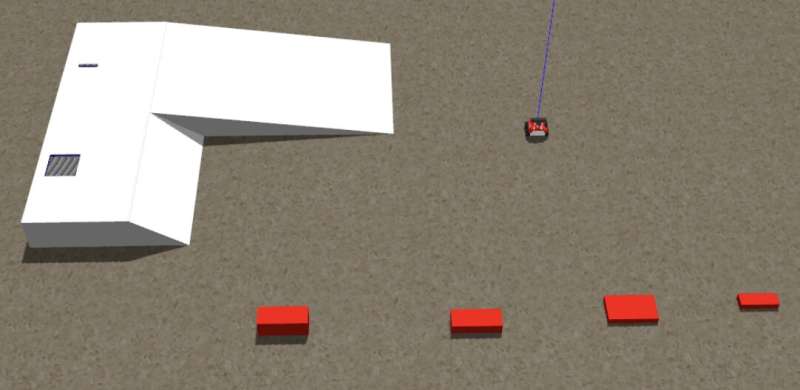October 14, 2022 feature
A new system that could improve robot navigation in uneven terrains

As mobile robots become more advanced, they also become easier to deploy in a wide range of real-world settings. One of the factors that will enable their large-scale implementation is their ability to autonomously move around within different types of environments.
So far, many mobile robots have achieved promising results in navigating simple environments, particularly those with a smooth floor or terrain. In the real-world, however, many environments, including industrial plants, some roads and natural environments, have uneven terrains, with holes or bumps in the ground, clutter and other obstacles.
Researchers at the Russian Academy of Sciences and the National Research University Higher School of Economics in Moscow have recently developed a new navigation system that could improve the ability of mobile robots to move on rough surfaces while also avoiding different types of obstacles. This system, presented in a paper pre-published on arXiv, could help to facilitate the deployment of robots in more complex and cluttered environments with uneven terrains.
"Safe navigation in uneven terrains is an important problem in robotic research," Stepan Dergachev, Kirill Muravyev, and Konstantin Yakovlev wrote in their paper. "We propose a 2.5D navigation system which consists of elevation map building, path planning and local path following with obstacle avoidance. For local path following we use the model predictive path integral (MPPI) control method."
The robot navigation system proposed by Dergachev and his colleagues is based on MPPI, an algorithm to optimize and correct a non-linear paths introduced by researchers at the Georgia Institute of Technology in 2016. For the purpose of their study, the team adapted this algorithm so that it would be suitable for optimizing paths in environments with uneven terrains, using 2.5D elevation maps.
"We use a local elevation map as an input for the MPPI algorithm," Dergachev and his colleagues explained in their paper. "MPPI is guided by terrain traversability values computed by this elevation map. These traversability values are computed from slope steepness, surface roughness and other parameters."
Dergachev and his colleagues evaluated their navigation system in a series of tests on simulated environments, using three different elevation maps. In these tests, the robots had to reach a specific location while overcoming or circumventing three distinct obstacles in its way, namely a truncated cone, a ramp and some pits.
The simulated environments used in these tests were created using the Gazebo simulator and were characterized by different obstacles and types of uneven terrain. The researchers tested their system's effectiveness in these environments using a model of a four-wheeled differential drive robot.
Dergachev and his colleagues found that their system performed remarkably well in their simulations, with the robot successfully circumventing obstacles and navigating uneven terrains almost 100% of the time. To confirm its potential, however, the team will eventually also need to test it in a real-world setting, using a physical robot.
If the system also performs well in a real environment, it could eventually be adapted and used in further research. Ultimately, it could thus promote the development of mobile robots that are better at navigating environments with uneven terrains.
"In the future, we plan to create a more efficient implementation of the MPPI algorithm by parallelizing computations using CUDA/OpenCL toolkits," the researchers concluded in their paper. "Another area of future work will be increasing the robustness of MPPI and adapting it to a larger class of dynamic systems."
More information: Stepan Dergachev, Kirill Muravyev, Konstantin Yakovlev, 2.5D mapping, pathfindings and path following for navigation of a differential drive robot in uneven terrains. arXiv:2209.07252v1 [cs.RO], arxiv.org/abs/2209.07252
© 2022 Science X Network

















